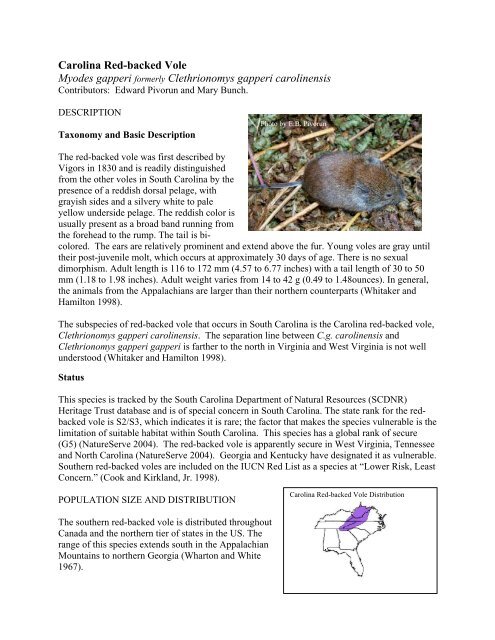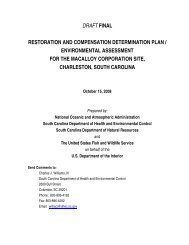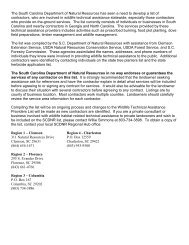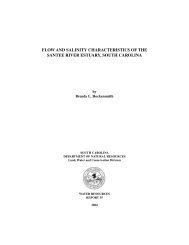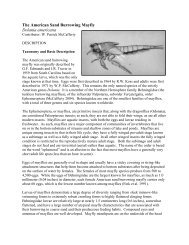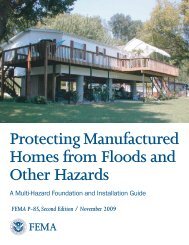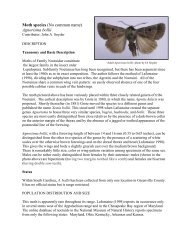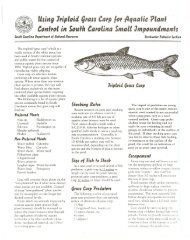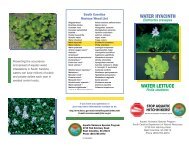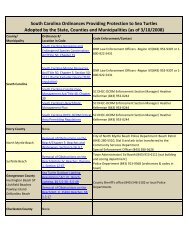Carolina Red-backed Vole - South Carolina Department of Natural ...
Carolina Red-backed Vole - South Carolina Department of Natural ...
Carolina Red-backed Vole - South Carolina Department of Natural ...
You also want an ePaper? Increase the reach of your titles
YUMPU automatically turns print PDFs into web optimized ePapers that Google loves.
<strong>Carolina</strong> <strong>Red</strong>-<strong>backed</strong> <strong>Vole</strong><br />
Myodes gapperi formerly Clethrionomys gapperi carolinensis<br />
Contributors: Edward Pivorun and Mary Bunch.<br />
DESCRIPTION<br />
Taxonomy and Basic Description<br />
Photo by E.B. Pivorun<br />
The red-<strong>backed</strong> vole was first described by<br />
Vigors in 1830 and is readily distinguished<br />
from the other voles in <strong>South</strong> <strong>Carolina</strong> by the<br />
presence <strong>of</strong> a reddish dorsal pelage, with<br />
grayish sides and a silvery white to pale<br />
yellow underside pelage. The reddish color is<br />
usually present as a broad band running from<br />
the forehead to the rump. The tail is bicolored.<br />
The ears are relatively prominent and extend above the fur. Young voles are gray until<br />
their post-juvenile molt, which occurs at approximately 30 days <strong>of</strong> age. There is no sexual<br />
dimorphism. Adult length is 116 to 172 mm (4.57 to 6.77 inches) with a tail length <strong>of</strong> 30 to 50<br />
mm (1.18 to 1.98 inches). Adult weight varies from 14 to 42 g (0.49 to 1.48ounces). In general,<br />
the animals from the Appalachians are larger than their northern counterparts (Whitaker and<br />
Hamilton 1998).<br />
The subspecies <strong>of</strong> red-<strong>backed</strong> vole that occurs in <strong>South</strong> <strong>Carolina</strong> is the <strong>Carolina</strong> red-<strong>backed</strong> vole,<br />
Clethrionomys gapperi carolinensis. The separation line between C.g. carolinensis and<br />
Clethrionomys gapperi gapperi is farther to the north in Virginia and West Virginia is not well<br />
understood (Whitaker and Hamilton 1998).<br />
Status<br />
This species is tracked by the <strong>South</strong> <strong>Carolina</strong> <strong>Department</strong> <strong>of</strong> <strong>Natural</strong> Resources (SCDNR)<br />
Heritage Trust database and is <strong>of</strong> special concern in <strong>South</strong> <strong>Carolina</strong>. The state rank for the red<strong>backed</strong><br />
vole is S2/S3, which indicates it is rare; the factor that makes the species vulnerable is the<br />
limitation <strong>of</strong> suitable habitat within <strong>South</strong> <strong>Carolina</strong>. This species has a global rank <strong>of</strong> secure<br />
(G5) (NatureServe 2004). The red-<strong>backed</strong> vole is apparently secure in West Virginia, Tennessee<br />
and North <strong>Carolina</strong> (NatureServe 2004). Georgia and Kentucky have designated it as vulnerable.<br />
<strong>South</strong>ern red-<strong>backed</strong> voles are included on the IUCN <strong>Red</strong> List as a species at “Lower Risk, Least<br />
Concern.” (Cook and Kirkland, Jr. 1998).<br />
POPULATION SIZE AND DISTRIBUTION<br />
<strong>Carolina</strong> <strong>Red</strong>-<strong>backed</strong> <strong>Vole</strong> Distribution<br />
The southern red-<strong>backed</strong> vole is distributed throughout<br />
Canada and the northern tier <strong>of</strong> states in the US. The<br />
range <strong>of</strong> this species extends south in the Appalachian<br />
Mountains to northern Georgia (Wharton and White<br />
1967).
There are no population estimates available in the southern Appalachian Mountains, which<br />
represent the southern end <strong>of</strong> the red-<strong>backed</strong> vole’s range. Trapping records from collections in<br />
Highlands, North <strong>Carolina</strong> and the Smoky Mountains National Park indicate that this species can<br />
attain high densities and maintain viable populations in suitable habitats (Pivorun, pers. obs). In<br />
addition, the population was observed to cycle over five to eight year intervals in the Highlands,<br />
North <strong>Carolina</strong> National Forest lands (Pivorun, pers. obs.); six to ten year cycles have been<br />
observed in other localities (Patric 1962). There is such a paucity <strong>of</strong> trapping records from <strong>South</strong><br />
<strong>Carolina</strong> that no data are available on population cycles. This species was one <strong>of</strong> the most<br />
abundant mammals on the summit <strong>of</strong> Mt. Rogers in western Virginia (Linzey 1998). Highdensity<br />
populations are usually located at altitudes above 610 to 915 m (2,000 to 3,000 feet). The<br />
majority <strong>of</strong> suitable habitat in <strong>South</strong> <strong>Carolina</strong> is located at lower altitudes and one would expect<br />
smaller population numbers in this state. The presence <strong>of</strong> voles in <strong>South</strong> <strong>Carolina</strong> may also be<br />
dependent upon movements <strong>of</strong> voles from higher altitudes in North <strong>Carolina</strong> that occur when<br />
population cycles result in high densities in the North <strong>Carolina</strong> mountains.<br />
The red-<strong>backed</strong> vole is restricted to the higher elevation habitats <strong>of</strong> <strong>South</strong> <strong>Carolina</strong> within the<br />
southern Appalachians ecoregion. Currently the only published records for this species are from<br />
Oconee (Pivorun et al. 1984) and Pickens Counties (Laerm et al. 1995). Suitable habitat for the<br />
<strong>Carolina</strong> red-<strong>backed</strong> vole is present in Greenville County. Current population studies are not<br />
being conducted on the distribution and abundance <strong>of</strong> this species in <strong>South</strong> <strong>Carolina</strong>.<br />
Predators <strong>of</strong> red-<strong>backed</strong> voles include snakes, owls, foxes, bobcats and weasels. Presumably,<br />
coyotes will use these as a food source. Although these voles are prey <strong>of</strong> several species,<br />
survival <strong>of</strong> the red-<strong>backed</strong> vole population is usually not threatened by these predators.<br />
HABITAT AND NATURAL COMMUNITY REQUIREMENTS<br />
The red-<strong>backed</strong> vole is found in the southern Appalachians ecoregion. Within that ecoregion, the<br />
vole can be found in habitat with mesic mixed forests, mesic deciduous hardwood, and high<br />
altitude coniferous forests and beech gaps. A mesic environment with an abundance <strong>of</strong> litter,<br />
rotting logs, moss covered rocks, exposed roots and rock crevices would be considered an ideal<br />
habitat. Generally, the presence <strong>of</strong> a bog area or streambed at altitudes above 762 m (2,500 feet)<br />
<strong>of</strong>fers an appropriate habitat (Webster et al. 1985). Neither forest age, nor successional stage, has<br />
been reported as critical factors in determining habitat preference. <strong>Red</strong>-<strong>backed</strong> voles do not<br />
colonize post burn communities as readily as other species (Merritt and Zegler 1991) but will<br />
inhabit clear cuts (Kirkland 1990; Schloyer 1977; Martell 1983; Monthey and Soutiere 1985).<br />
In <strong>South</strong> <strong>Carolina</strong>, red <strong>backed</strong> voles are only found in Oconee and Pickens County at altitudes<br />
above 915 m (3,000 feet) in mixed deciduous forests associated with boggy and stream bed<br />
habitats that contain rhododendron. In the <strong>South</strong>ern Appalachians, associated species include the<br />
woodland jumping mouse (Napaeozapus insignis), star-nosed mole (Condylura cristata), the<br />
hairy-tailed mole (Parscalops breweri) and masked shrew (Sorex cinereus) (Watts 1970).<br />
The red-<strong>backed</strong> vole utilizes underground tunnels <strong>of</strong> other species such as shrews and moles for<br />
den and nest sites; they also use crevices among exposed roots and rocks for these purposes.
These voles forage along the ground and around downed trees. There is very little known about<br />
the use <strong>of</strong> subterranean fungi by this species, even though this is considered a primary food<br />
source (Fisher 1968).<br />
CHALLENGES<br />
In <strong>South</strong> <strong>Carolina</strong>, a large portion <strong>of</strong> the habitat in the Blue Ridge ecoregion that is appropriate<br />
for red-<strong>backed</strong> voles is on public land, including National Forests, State Parks and SCDNR<br />
managed properties. Additionally, some lands that contain red-<strong>backed</strong> vole habitat are owned or<br />
held in easement by various land trusts. None <strong>of</strong> these properties were purchased specifically to<br />
protect the red-<strong>backed</strong> vole; however, the species benefits from acquisition and protection <strong>of</strong> its<br />
habitat. While these protected areas provide needed habitat, populations on private lands are still<br />
impacted by land conversion.<br />
Land development in the southern Appalachians represents a major challenge to the red-<strong>backed</strong><br />
vole. Land use in this region is rapidly changing from rural/agricultural to urban. An<br />
unpublished study conducted by SCDNR showed a 4-fold increase in development to every onefold<br />
increase in population between 1983 and 1998 (Richard Lacy, pers. comm.). As these<br />
conversions occur, habitat for this species is being lost. Even when development proceeds in<br />
close proximity to existing red-<strong>backed</strong> vole habitat, the species may be adversely affected as<br />
these animals require relatively undisturbed habitats. Additionally, the changes in hydrology that<br />
result from urbanization will affect habitat for this species. <strong>Red</strong>-<strong>backed</strong> voles require wet areas,<br />
like bogs; these areas are expected to diminish as development continues.<br />
CONSERVATION ACCOMPLISHMENTS<br />
Terrestrial small mammal surveys that have been conducted in the <strong>South</strong> <strong>Carolina</strong> mountains<br />
have provided data to better understand habitat requirements and population dynamics <strong>of</strong> the<br />
various rodent and insectivore species. These studies were possible as a result <strong>of</strong> partnerships<br />
between several interested parties including the University <strong>of</strong> Georgia, the US Forest Service,<br />
Clemson University and SCDNR.<br />
CONSERVATION RECOMMENDATIONS<br />
• Discourage major developments in known red-<strong>backed</strong> vole habitat in the Blue Ridge<br />
ecoregion<br />
• Complete ecoregion-wide surveys for red-<strong>backed</strong> vole distribution and density. Surveys<br />
and survey techniques should be standardized throughout the southeast so that results and<br />
data are readily comparable. All capture data should be made available to the statewide<br />
Heritage Trust database as well as shared with neighboring states.<br />
• Concurrent with surveys, resolve the subspecies designation for red-<strong>backed</strong> voles (C. c.<br />
carolinensis) and distribution using molecular data and intensive morphometric analysis.<br />
This will require cooperation or partnerships with neighboring states.<br />
• Provide information on the ecological role and benefits <strong>of</strong> red-<strong>backed</strong> voles. This species<br />
is not considered a nuisance species. This information would allow for better<br />
management <strong>of</strong> private, state and federal lands in the montane regions <strong>of</strong> the state;
management would be partially based on consideration <strong>of</strong> the impact on mammalian<br />
species that are major prey items for predators such as fox, bobcat and birds <strong>of</strong> prey.<br />
MEASURES OF SUCCESS<br />
As research and management needs are identified, projects should be proposed and prioritized by<br />
those with the greatest conservation applicability. Surveys and density estimates in the southern<br />
region should provide some population estimations, which will be used to more accurately rank<br />
the species and prioritize future management needs.<br />
LITERATURE CITED<br />
Cook, J.A. and G.L. Kirkland, Jr. 1998. Clethrionomys gapperi (Vigors 1830) <strong>South</strong>ern red<strong>backed</strong><br />
vole; Gapper’s red-<strong>backed</strong> mouse. In: North American Rodents. Status Survey<br />
and Conservation Action Plan, D.J. Hafner, E. Yensin and G. L. Kirkland, Jr., Editors.<br />
IUCN/SSC Rodent Specialist Group. IUCN Cambridge, UK. 171 pp.<br />
Fisher, R.L. 1968. An ecological study <strong>of</strong> the red-<strong>backed</strong> vole, Clethrionomys gapperi, in<br />
Central New York. Unpubl. Ph.D. diss. Cornell Univ. 79 pp.<br />
Kirkland, G.L. 1990. Patterns <strong>of</strong> initial small mammal community change after clearcutting <strong>of</strong><br />
temperate North American forests. Oikos. 59:319-320.<br />
Laerm, J., E. Brown, M.A. Menzel, A. Wotjalik, W.M. Ford and M. Strayer. 1995. The masked<br />
shrew, Sorex cinereus (Insectivora: Soricidae), and the red-<strong>backed</strong> vole, Clethrionomys<br />
gapperi (Rodentia:Muridae), in the Blue Ridge Province <strong>of</strong> <strong>South</strong> <strong>Carolina</strong>. Brimleyana,<br />
22:15-21.<br />
Linzey, D. 1998. The Mammals <strong>of</strong> Virginia. McDonald & Woodward Publ. Co. Blacksburg,<br />
Virginia. 459 pp.<br />
Martell, A.M. 1983. Changes in small mammal communities after logging in north central<br />
Ontario. Canadian Journal <strong>of</strong> Zoology. 61:97-98.<br />
Merrit, J.F. 1981. Clethrionomys gapperi. Mammalian Species No. 146. 9 pp. Muul, I. and F.W.<br />
Carlson. 1963. <strong>Red</strong>-back vole in trees. Journal <strong>of</strong> Mammalogy. 44:415-416.<br />
Merritt, J. and D.A. Zegers. 1991. Seasonal thermogenesis and body mass dynamics <strong>of</strong><br />
Clethrionomys gapperi. Canadian Journal Zoology. 69:2771-2777.<br />
Monthey, R.W. and E. Soutiere. 1985. Responses <strong>of</strong> small mammals to forest harvesting in<br />
northern Maine. Canadian Field <strong>Natural</strong>ist. 99:13-18.<br />
NatureServe. 2004. NatureServe Explorer: An online encyclopedia <strong>of</strong> life. Version 4.0.<br />
NatureServe, Arlington, Virginia. (online) Accessed March 23, 2005 at<br />
http://www.natureserve.org/explorer.


